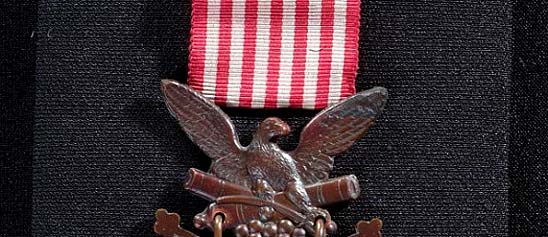Text and photograph from Gardner's Photographic Sketchbook of the War, Vol. II. Negative by Timothy H. O'Sullivan, text and positive by Alexander Gardner.A portion of the battle-field of Gettysburg, located in front of Little Round Top, is known as the Slaughter Pen.
- Description
-
Text and photograph from Gardner's Photographic Sketchbook of the War, Vol. II. Negative by Timothy H. O'Sullivan, text and positive by Alexander Gardner.
-
A portion of the battle-field of Gettysburg, located in front of Little Round Top, is known as the Slaughter Pen. Upon the conclusion of that engagement, the ground was found in many places to be almost covered with the dead and wounded. This sketch only represents a few of the dead, the wounded having been removed to the hospitals. Gen. Crawford, commanding the Third Division of the Fifth Corps, was placed near this ravine, on the second day of the fight, to support Barnes' Division, and the scenes which transpired cannot be better described than in his own words before the Committee on the Conduct of the War. He says: "I heard the cheers of the enemy, and looking in front across a low ground, I saw our men retreating in confusion; fugitives were flying across in every direction; some of them rushed through my lines. The plain in front was covered with the flying men. The regular division had marched out past my left flank. A wheat field lay between two masses of woods directly in my front. A stone wall skirted these woods from right to left. The enemy, in masses, were coming across this wheat field, having driven everything before them. Their line of skirmishers had crossed the stone wall, and their column was coming across the low ground towards the hills upon which we stood. I ordered an immediate charge upon the enemy by the whole division.
-
The division moved forward at once: Two volleys were fired, when the whole command started at a double-quick. We met the enemy in the low ground, drove them back to the stone wall, for the possession of which there was a short struggle, and at which two regiments which had been massed on the flanks of the line, were deployed, drove the enemy through the woods, and over the wheat field, to the ridge beyond. The line was there permanently established." On Friday afternoon, he was ordered to clear the woods in his front, and of that movement says: "I directed the command at once to advance. Hardly had the men unmasked from the hill before a battery of the enemy, stationed on a ridge beyond the wheat field opened, with grape and canister. As soon as the skirmishers opened fire on the cannoniers, the battery limbered up and fled. I then formed a line, and directed it to cross the wheat field and clear the woods. In doing this, they came upon a brigade of Hood's division, under Gen. Anderson or Gen. Bonham, composed of Georgia troops; they attacked them, capturing 260 prisoners, the battle-flag of the 15th Georgia, re-taking nearly all the ground that had been lost, and over 7,000 stand of arms, besides one 12-pound Napoleon gun and three caissons, and all the wounded, who had lain entirely uncared for. We permanently held that line. Hood's division was driven off nearly a mile."
- Location
-
Currently not on view
- date made
-
1863-07
- maker
-
Gardner, Alexander
- ID Number
-
1986.0711.0334.44
- accession number
-
1986.0711
- catalog number
-
1986.0711.0334.44
